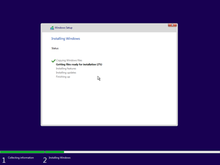|
Windows Setup
  Windows Setup is an installer that prepares a computer for a Microsoft Windows installation by allowing the user to pick installation settings (modifying partitions if necessary) and copying the files to the drive. The early versions of Windows required an existing compatible version of DOS operating system in order to be installed. The Windows NT family, from 3.1 through 5.0 featured text-based installation that prompted users to a GUI wizard in the final steps. The 9x family installer was similar to NT despite it being MS-DOS-based. Additionally, it did not need preinstalled DOS as a requirement. With the release of Windows NT 6.0 (which Windows Vista and Windows Server 2008 are based on), Microsoft introduced a fully graphical setup environment and UEFI support (partial in Windows Vista and 7, full UEFI support on Windows 8 onwards). The new graphical setup environment is based on Windows Preinstallation Environment. Windows 1.x and Windows 2.xThe installation of Windows 1.0, Windows 2.0, Windows 2.1 requires that a compatible version of MS-DOS is installed. The user must specify any hardware such as mice or printers during installation. After the installation, Windows was to be started either manually by typing "WIN.COM" at the command prompt, or configured for automatic startup by adding WIN.COM to the end of AUTOEXEC.BAT. Windows 3.xThe installation of Windows 3.0, Windows 3.1 and Windows 3.2 requires that a compatible DOS operating system is already installed. The installer attempts to detect network cards, mice, and other hardware on its own but will rely on the user to specify hardware if it cannot find them. After the installation, Windows was to be started either manually by typing "WIN.COM" at the command prompt, or configured for automatic startup by adding WIN.COM to the end of AUTOEXEC.BAT.[1] Windows 9xWindows 95, 98, and Me utilize a similar setup process, which does not require MS-DOS to be already installed. The setup application can be launched from a DOS environment (typically a DOS boot disk, also containing utilities such as fdisk to conduct disk partitioning), or from an existing Windows installation for in-place upgrades. If launched from DOS, a stub application first bootstraps a minimal environment based upon Windows 3.1, which is then used to launch a graphical wizard to begin the first phase of the installation process. In any case, after initial configuration and the copying of files to the selected installation folder, the computer then reboots into the installed OS to conduct the second phase, including hardware detection, driver installation, and post-install housekeeping before installation is complete.[2] Windows NTBefore Windows Vista/Windows Server 2008 The setup process introduced with Windows NT 3.1 remained in effect until the release of Windows Vista. The general process is:
All versions of Windows NT up to Windows Server 2003, except for Windows XP Home Edition, prompt the user to enter an Administrator password. On Windows 2000, Windows XP and Windows Server 2003, the Recovery Console is included to repair damaged installations. It allows the user to repair disk and boot record errors, and copy missing or corrupted files to the destination folders. After Windows Vista/Windows Server 2008Windows Vista, Windows Server 2008, and subsequent operating systems all utilize Windows Preinstallation Environment (Windows PE) as the installation environment. Windows PE features a graphical user interface with mouse support from the beginning, rather than requiring a text-only phase as in previous versions. The concept of F6 disks has been improved to provide support for computers without floppy drives; the loading of drivers from CD-ROMs and USB flash drives is now supported. Support for installing Windows onto FAT partitions has been dropped; Windows must be installed onto an NTFS partition.[4][failed verification] Process
Windows 8 and laterWindows 8 introduces a new secondary installer known as the Upgrade Assistant, replacing Windows Setup for upgrade installations. Designed to be simpler and faster than previous installation methods, it analyses the system's hardware and software for compatibility with Windows 8, allows the user to purchase, download, and install the operating system, and migrate files and settings from the previous Windows installation in the case of a clean install.[5][6] Windows Setup is still used when booting from installation media.[6] On Windows 10, a sister program to Upgrade Assistant known as "Media Creation Tool" was introduced, which is used to download the Windows OS files and generate ISO images or USB boot media.[7] In January 2024, Microsoft began to replace Windows Setup on the Windows 11 boot media with a revamped version based on the UI of Upgrade Assistant. Microsoft stated that the new process would maintain all advanced features available in the existing setup process.[8] References
|
Portal di Ensiklopedia Dunia